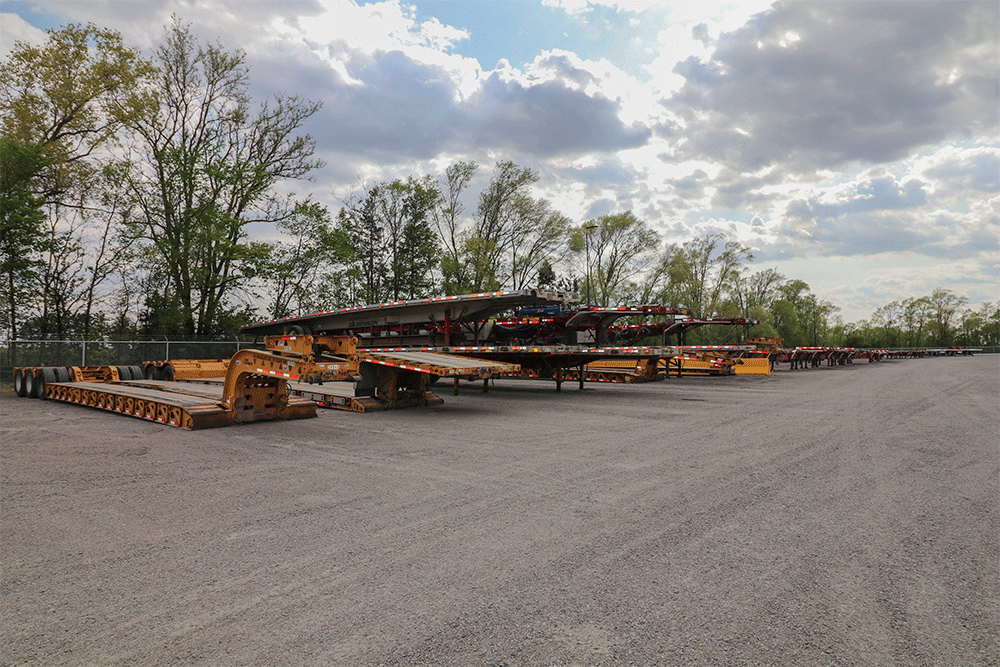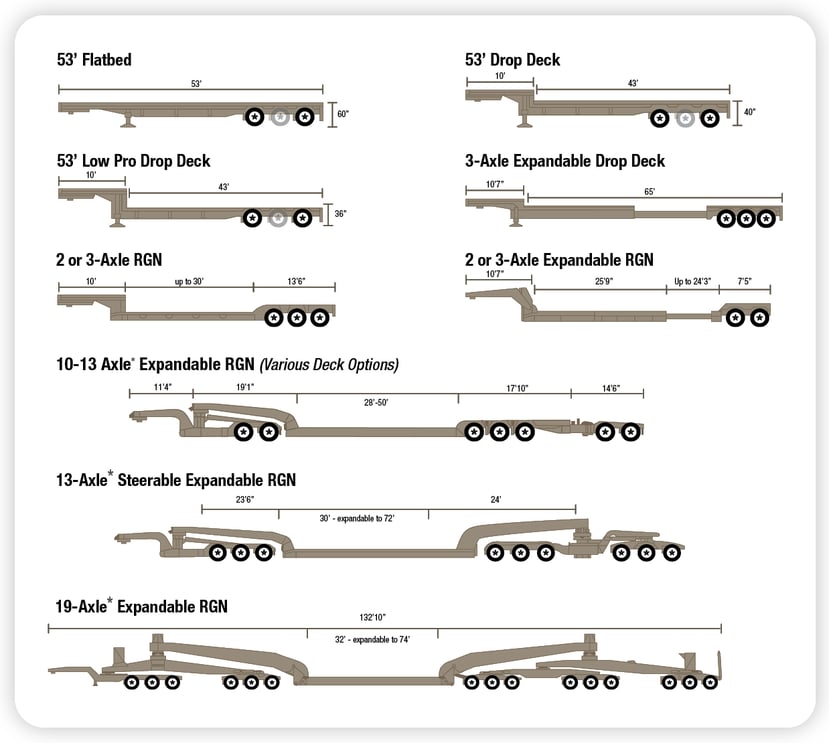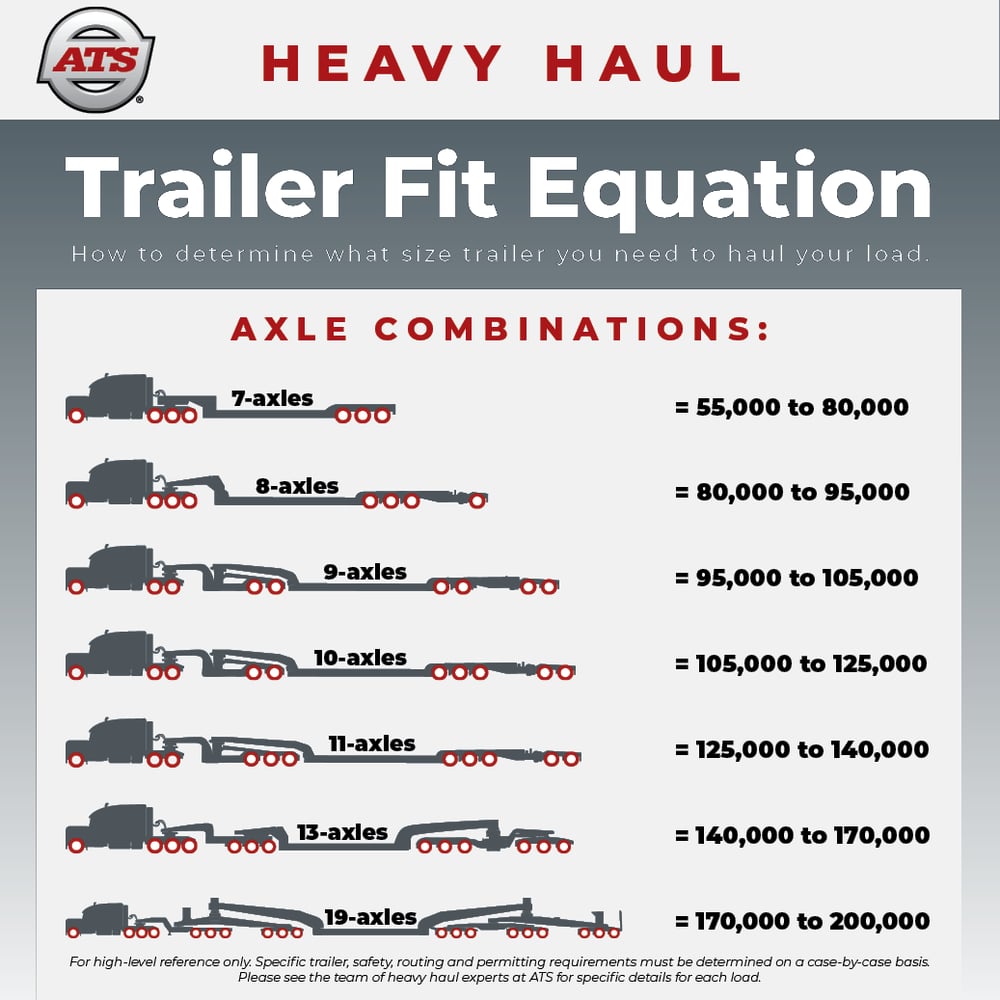
If you ship equipment that requires specialized trailers, it can be hard to remember which trailer type makes the most sense for you from both a cost and safety standpoint. After all, the equipment you’re shipping is what impacts the trailer your carrier uses, not the other way around.
Beyond the standard flatbed trailer, you can find step deck trailers, removable gooseneck (RGN) trailers, multi-axle trailers and more. Of course, each of those trailer types is associated with a different cost for various reasons. It can be overwhelming to try and keep track, let alone know what each will cost you to use.
Luckily for you, there are transportation providers who specialize (no pun intended) in this sort of thing — including us. (In fact, that’s how ATS got its start in 1955.)
In this article, we’ll break down what factors play a part in what you pay for transportation costs, how the different types of specialized trailers impact your freight costs and what you can do to save as much as possible.
What Factors Impact Over-Dimensional (OD) Transportation Costs?
Several factors can impact how much you pay to move your over-dimensional freight — which is freight larger than "legal limits" set by each state and province. While those dimensions vary slightly, the general rule is anything beyond 53 feet long, 8 feet, 6 inches wide or 13 feet, 6 inches tall is considered over-dimensional.
Those factors include:
- Dimensions
- Weight
- Route
- Equipment Needed
- Expertise Needed
Let’s get into the reasons why.
Dimensions
When talking about the dimensions of your freight, that includes the height, width and length of what’s on the trailer. While each of those aspects plays a part, height plays the biggest role when it comes to freight cost.
Think about it like this: increasing the width of your freight still provides the flexibility to take a wider road or hang over the sides of the road, when possible. Length is similar, but you’ll need a longer trailer instead.
When it comes to height, you have to consider bridges, power lines, stoplights and more. You may be able to manipulate power lines — with the help of the area electric company — and may be able to temporarily remove stoplights, but you’re not manipulating or removing a bridge to get your tall freight through.
Weight
Like the dimensions of the freight, the weight impacts what routes can be used. That’s because different roads are designed to withstand varying weights on a consistent basis. Compare your local county highway versus the interstate.
This holds especially true in the northern parts of the country in the spring. That’s because the prolonged cold temperatures in the winter cause the roads to freeze and contract. Then in the spring, temperatures rise above freezing during the day, causing the asphalt to expand and let melting ice get into the cracks, before freezing again at night.
That constant change in temperatures leaves roadways softer and more susceptible to cracks and breakage.
To reduce the risk of damage to roadways, many states and local municipalities restrict the routes heavy trucks can take, particularly in the spring.
Route
Unlike your standard sedan, heavy trucks don’t always have the luxury of typing their destination into Google Maps and hitting “start.” And the more OD the cargo gets, the more restricted it gets (see dimensions and weight for the reasons why).
The further off-track the truck needs to go, plus the potential route modifications that need to be made — like road widening, sign removal and more — will impact your shipping freight rates.
Equipment Needed
A lot of factors weigh into the decision on what equipment is needed to move your freight, including securement, weight and dimensions.
The dimensions of your freight will be the starting point to find the right trailer and it’s pretty simple at first — does it fit? Carriers use that thought-process until they find the right-sized trailer. They use that same logic for weight, except “can it support the weight?” is the factor considered.
Finally, securement holds a lot of weight for the safest transportation providers. If your freight can’t properly be secured to the trailer — even if it fits fine — it’s not the right trailer. The last thing a responsible carrier would want is for your freight to fall off and damage something, or worse.
Expertise Needed
As you’ve probably gathered by now, the bigger the freight, the bigger the equipment needed to move it. That comes with more expertise behind the wheel (at least if you’re working with a well-qualified carrier), which comes at a premium.
What Carriers Do to Address Freight Cost Challenges
The most common way to address weight is by adding axles to the trailer. This spreads it out over a larger area so it’s not so concentrated. Have you ever been on a boat or airplane that’s not full, so they ask people to spread out? There’s a reason for that.
A general rule-of-thumb is you can put 10,000 pounds per axle between the tractor and trailer. For example, if you’re moving a 70,000-pound load, you’d need a 7-axle tractor-trailer combination (see the graphic below for more). Again, that’s a general rule of thumb as other factors may also be considered.
As mentioned in the dimension section, the higher the load sits, the more restrictions there are for carriers, so many trailers have been designed to address that.
A standard flatbed trailer deck sits 5 feet above the ground, so the cargo is limited to 8 feet, 6 inches tall before being considered over-dimensional. A drop deck or step deck trailer’s deck is 40 inches from the ground, so you now have an extra 20 inches to work with.

While these are two common trailer varieties, dozens of others aim to address the height problem — some of which can get as low as 10 inches from the ground. That means your cargo can be 12 feet, 8 inches tall and still be within “legal” dimensions (i.e., not OD, which begins from a height standpoint at 13 feet, 6 inches).
Some carriers even have direct relationships with the leading trailer manufacturers, which means they can tailor a trailer to fit the unique needs of certain markets. Or if you need an even more specialized trailer to haul your components, it can be manufactured.
What you’ll learn is as you get more specialized on the trailer type, the harder it is to find, which means it’ll cost more.
How You Can Find Ways to Save on OD Shipping Costs
Depending on your needs, you should be able to find a carrier with a trailer that will work perfectly fine with no concerns.
RGN, double drop, double drop stretch and other low-profile trailers can be easy to find — especially in carriers with larger fleets. Since 13 feet, 6 inches from the ground is the threshold before being considered OD, these trailers provide more flexibility with load height to keep you within “legal” dimensions.
Using one of the common lower-riding trailers will save you money because they prevent the need to order higher-priced permits — or even order permits at all.
You should also be able to find two and three-axle RGNs fairly easily, which means loads weighing up to 70,000 pounds (remember, the number of axles on the tractor plays a part too) can be covered pretty quickly.
Even if you need a more specialized trailer, you can pay less of a premium if you consult your transportation partner with enough advance notice. The less time they have to find the right trailer, the harder it will be to get it to the correct destination on time — which will cost you more.
Finally, there’s a chance you’ve heard what I’m about to say (probably even from us) before, but it’s worth hearing again because it plays a major role in transportation costs. If you’re the original manufacturer of what you’re shipping, get logistics involved early.
Getting that area of expertise in the manufacturing discussion early could play a major part in the decisions you make. This is no exaggeration when I say you could literally save tens of thousands of dollars with as little as an inch and a half. I’ve experienced it firsthand where the cost impact was well above $100,000. I’m guessing that kind of number would make you think twice about a manufacturing decision.
Ultimately, if you include a transportation expert early on and allow time for planning, you should be able to avoid any unnecessary freight costs.
What to Consider When Moving Your Next Specialized Load
When you're ready to move your next load that requires a specialized trailer, consider the dimensions, weight, route, equipment and expertise needed when planning your budget. These factors play a major role in what trailer is used to move your freight — with the ultimate goal of saving you from needing OD permits, if possible.
If you can find a carrier with the trailer variety to accommodate different dimensions of your various freight, you'll have better luck staying within legal dimensions.
Ultimately, the best bet is to get a trusted transportation partner involved early in your manufacturing process so they can help you make decisions that could save you tens of thousands of dollars.
Clear communication between you and your transportation provider is vital to getting your freight moved safely, on-time and within budget.




